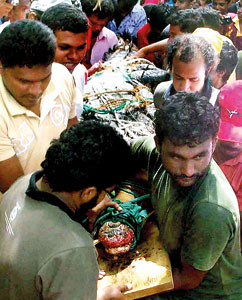A 12.2-foot male saltwater crocodile, the reptile believed to have killed an 18-year-old Matara schoolgirl, was captured last Sunday (April 15) by a team of young environmentalists and wildlife officers.
Led by Dr. Tharaka Prasad of the Wildlife Department, the team set up a baited box trap designed for the purpose on the banks of the river Nilwala, some 100 metres from the spot where the girl had been seized by a croc.
The trap was submerged and camouflaged with twigs and branches. The team meanwhile set up camp in a nearby school, Malimbada North. To ensure that the reptile, if trapped, would not die in captivity, the team kept a 24-hour watch, intermittently checking the trap, day and night. Crocodiles are cold-blooded creatures that need to regulate their body temperature by moving its body; it could be fatal for a croc to remain confined in a close space indefinitely.
 |
| Wildlife officers and volunteers struggled to subdue the 12.2 foot crocodile. Pix by Krishan Jeewaka Jayaruk |
Dedicating their Avurudu vacation to the cause, the team waited patiently, fearing angry villagers might trap the crocodile themselves and kill it.
The giant Ragama crocodile that was caught recently died as a result of blows sustained and also injuries caused by the hook used to bait the amphibian.
The crocodile was captured on Sunday morning, three days after the trap was set. The powerful reptile thrashed around furiously as the team dragged the box trap on to land. News spread fast, and in minutes a crowd of villagers had gathered to view the reptile.
When the Sunday Times came on the scene, a police team was in place to control the crowd and keep the villagers of Malimbada clear of the trapped croc.
The next stage of the operation was to get the croc out of the box trap, and tie it down to be taken to another location. The moment the trap was opened, the crocodile attempted to rush into the water. The team tied its tail and strapped the animal around the neck and gaping mouth. Some sat on the croc to clam it while it was tied up.
There was a round of applause from the villagers once the creature was finally subdued. The creature was then taken to the Malimbada North School, followed by the crowd. “We could have caught the animal earlier if the villagers had not disturbed the animal,” said team member Sujeewa Chandana. “When you disturb an animal’s habitat, it moves away. It takes a few days before the animal returns to its home ground.”
Unlike the Ragama crocodile, this crocodile did not suffer any ill-treament at the hands of its captors. In fact, the villagers took turns to pour buckets of water on the reptile to prevent it from getting dehydrated.
As the reptile was being removed from the village, the rescue team had to take it past the home of Nuwanthika, the schoolgirl victim. Her parents stood looking on, tears in their eyes. The mother was heard to say, “Please take away it from here.”
There were reports of the safe house or enclosure for Nilwala Ganga crocodiles was to be set up in Kirala Kele, a few kilometres away, and that the captured crocodile could meanwhile be accommodated at the Dehiwala Zoo.
The rescue team was already on its way to the zoo, and was close to Colombo, when they received a message that the Dehiwala Zoo could not accept the crocodile.
The team was forced to turn back. Their only option was to head to the Yala National Park, where the saltwater crocodile was released into the wild. |


